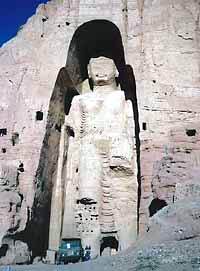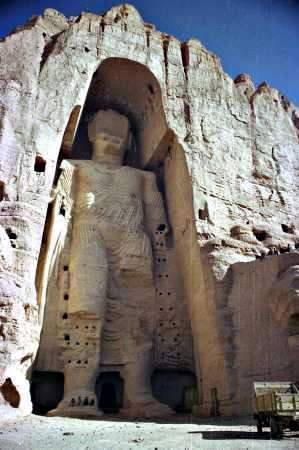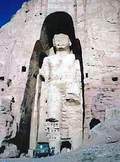Taliban go ahead and blast
Buddha's statues
Agencies
(Kabul, March 1)
[Vietnamese version]

Heritage
Killer: This undated picture shows an Afghan military truck parked under the
shadow of a huge Buddha statue in the central province of Bamiyan. Afghanistan, a famous
Buddhist center before Islamic conquerors invaded the country around 1,400 years ago, is
famous for its two massive and ancient Buddha statues.
DISREGARDING INTERNATIONAL outcry
over its decision to destroy the ancient Bamiyan Buddha statues and other heritage
artefacts, Afghanistan's Taliban regime on Thursday began destroying the statues in
various cities by using cannons and battle tanks to blast them.
Taliban Minister of Information
and Culture Qudratullah Jamal said militiamen started wrecking the almost 2,000-year-old
Buddhist masterpieces in the central province of Bamiyan, including the world's tallest
standing Buddha measuring 165 feet, after sunrise.
"We will use all means,
including cannon and tanks, to destroy the statues," the Taliban Minister said.
India termed the destruction of
the statues as an "absolute outrage". An MEA spokesman said in New Delhi that
the "Taliban are persisting with their obscurantist and medieval programme in
destroying valuable cultural, historical and archaeological artefacts."
An edict announced on Monday by
the militia's supreme leader, Mulla Mohammad Omar, calling for the destruction of all
statues in line with "Islamic" laws, has shocked the world.
Appeals for their preservation
have come from the US, France, Germany, Thailand, Japan, Sri Lanka, Iran, Pakistan,
Germany, Russia, India and UN Secretary General Kofi Annan.
Koichiro Matsuura, chief of
Unesco, said he had convened an emergency meeting of members of the Organisation of the
Islamic Conference.
"They are destroying statues
that the entire world considers to be masterpieces," Matsuura said.
Afghan Foreign Minister Wakil Ahmad Mutawakil
said the edict was irreversible. "Have you ever seen any decision of the Taliban
reversed?" Mutawakil asked.
- Afghanistan's famous
Buddhas under death sentence
- (AFP)

The
53-meter (175-foot) tall, 2000-year-old Buddha statue located in Bamyan, about 150
kilometers (90 miles) west of the Afghan capital Kabul, is shown in this undated photo.
Afghanistan's hardline Taliban rulers ordered the destruction, Monday, Feb. 26, 2001 of
all statues as insulting Islam, including this world's tallest standing Buddha statue
which was already damaged in fightings. (AP Photo)
KABUL, Feb 26 (AFP)
Some of the earliest examples of Buddhist
art are under a sentence of death in Afghanistan after the ruling Islamic militia ordered
their destruction Monday.
The Taliban militia, who have already
fired mortars at two ancient Buddha statues in central Bamiyan province, have now decided
to finish them off.
The massive Buddhas, carved into a
sandstone cliff near the provincial capital Bamiyan, stand 50 meters (165 feet) and 34.5
meters tall and date back to the second century AD.
Before their faces were lost to the
elements and Taliban vandalism, they wore the same serene smiles of the much later Buddhas
in the far East, but their classical features and Hellenistic Greek robes represented
their unique place not just in the history of Afghanistan, but of the world in general.
Previously protected by hordes of pilgrims
and monks who lived in nearby caves, the statues are now only visited by children who
climb all over them.
When they were built, Afghanistan was one
of the most cosmopolitan regions in the world, a melting pot of merchants, travellers and
artists from China and India, central Asia and the Roman Empire.
Now, under the Taliban, it is a place
where few travellers dare to visit, where ethnic minorities live in fear of persecution or
take up arms to defend themsleves, and where anything "un-Islamic" is forbidden
or denied.
Bamiyan was still a Buddhist land in the
mid-800s. Islam was not fully established there until the 11th century, but either way,
the Taliban's zealous project of re-creating a Mohammadean world of pure-Islam now has no
room for history.
They have banned photographs of living
creatures, television and music. Men are forced to grow long beards like the Prophet, and
women are barred from most work and official education.
The militia's supreme leader, Mulla
Mohammad Omar, a veteran of the 1979-89 Soviet war and an Islamic student (Talib) who
shuns most contact with the outside world, has now ordered all statues in Afghanistan to
be destroyed.
His edict was broadcast on Taliban radio
as a visiting group of Western diplomats visited Kabul to check reports of official
vandalism of ancient relics in the national museum.
Mortars were fired at the small Buddha's
groin in 1998 and a year later burning tyres were placed on the chin of the larger figure,
causing a long smoke stain.
Now the silent guardians of Afghanistan's pre-Islamic
history are again in the Taliban's sights.
- Taliban to destroy
world's tallest Buddha statue
- (AP)

An undated photo of the world's tallest Bhuddha statue at
Bamiyan in Afghanistan. (AP)
|
Afghanistan's hardline Taliban rulers, who
revile images as against Islam, ordered the destruction Monday of all statues, including
the world's tallest standing Buddha and a smaller one. The order came from the Taliban's
supreme leader Mullah Mohammed Omar who issued an edict declaring statues, including the
ancient Buddhas, as insulting to Islam. Afghanistan's ancient Buddhas are located in
Bamiyan, about 150kms west of the Afghan capital of Kabul. The tallest Buddha, measuring
53 metres is the world's tallest standing Buddha. The smaller one stands 37 metres. The
two statues, which have been damaged in fighting in the area, were carved out of the
Afghan mountainside in the fifth century. It's not clear what prompted the latest Taliban
edict.
The Taliban espouse a harsh brand of
Islamic law that bans most forms of light entertainment, all photography, requires men to
wear beards in keeping with the fashion of Islam's prophet Mohammed. The Taliban also
require everyone to pray five times a day, as required in the Muslim holy book the Koran.
Many of the Taliban's edicts are directed against women, who are required to wear the
all-enveloping burqa, travel with a male relative. Women are not allowed to work and
schools for girls beyond 8 years old is not allowed, although the Taliban say they will
allow it when fighting ends.
The Taliban rule roughly 95 per cent of
the country and the opposition, led by ousted President Burhanuddin Rabbani, the remaining
five percent. As well as the giant Buddhas, Afghanistan's museum contains a treasure-trove
of Buddhist-era artifacts. Much of the museum was destroyed in the bitter fighting between
rival Islamic factions, including Rabbanis, between 1992 and 1996 when the Taliban took
control. Many of the artifacts were stolen and sold on the open market. Some have appeared
in museums around the world. The tallest of the two giant Buddhas has already been damaged
by zealous Taliban soldiers who fired rocket propelled grenades at it. There have been
reports that the faces of the Buddhas have been disfigured. Faces are forbidden in Islam,
according to the Taliban.
- Taliban begins demolition, VHP
vows retaliation

An undated photo of the world's tallest Bhuddha
statue at Bamiyan in Afghanistan. (AP)
|
KABUL/NEW DELHI: The ruling Taliban
militia on Thursday began demolishing statues across Afganistan, disregarding
international opinion. The move evoked a strong response in India, with the Vishwa Hindu
Parishad (VHP) threatening suitable "reaction" in Rajasthan's communally
sensitive Ajmer.
In Kabul, Afghanistan Radio quoted Taliban
information minister Qudratullah Jamal as saying the Taliban had started destroying
statues in Kandahar, Bamiyan, Herat and Kabul Museum, following a fresh decree from its
Chief Mullah Omar. ``We will use all means, including canons and tanks, to destroy the
statues,'' he said. Jamal said the destruction of scores of pre-Islamic figures was
designed to stop the worshipping of "false idols," throughout the country.
He said militiamen started wrecking the
almost 2,000-year-old Buddhist masterpieces in the central province of Bamiyan, including
the world's tallest standing Buddha measuring 50 metres, after sunrise. The Taliban
soldiers were also at "work" in the Kabul museum and elsewhere in the provinces
of Ghazni, Herat, Jalalabad and Kandahar.
The decree for the destruction of statues
was issued after consultation with religious leaders and the Taliban Islamic Supreme
Court, the Minister said. The orders for destruction have been issued ``because these
statues have remained as a shrine of infidels and they are worshipping these statues
still...God Almighty is the real shrine...all false shrines should be smashed,'' the
decree said.
An edict announced Monday by the militia's
supreme leader, Mulla Mohammad Omar, calling for the destruction of all statues in line
with "Islamic" laws, has caused shock around the world.
The VHP on Thursday joined issues with the
Taliban over the destruction of statues, including the Bamiyan buddhas and threatened a
"reaction" in communally sensitive Ajmer town of Rajasthan if they do not stop
"insulting" Rajput warrior Prithviraj Chauhan's memorial in Ghazni.
"The destruction of Bamiyan statues
is an insult to Budhhism," VHP senior vice-president Acharya Giriraj Kishore told
reporters here.
Alleging that the 'samadhi' of Hindu
warrior Prithviraj Chauhan in Ghazni was being "insulted" by the Taliban regime,
Kishore said, "people in his erstwhile capital of Ajmer are agitated over it and they
may react if it does not stop."
Asked what was meant by
"reaction", Bajrang Dal leader Surendra Jain said, "you never know how
people react."
The dargah of famous Sufi saint Khwaja
Moinuddin Chishti in Ajmer commands a massive following across the Indian sub-continent,
including a large number of Hindus, and is cited as an example of communal harmony.
The two massive Bamiyan Buddhas, carved
into a sandstone cliff near the provincial capital in central Afghanistan, stand 50 metres
and 34.5 metres tall, respectively, and were built around the second century.
Appeals for their preservation have come
from India, the US, France, Germany, Thailand, Japan, Sri Lanka, Iran and UN Secretary
General Kofi Annan.
India on Thursday sent a former foreign
secretary to a UNESCO-sponsored meeting in Paris to discuss the destruction of the
Buddhist statues.
"The statues belonged to Buddhists
all over the world and not to Afghanistan alone," said R P Perera, a UNESCO official
based in New Delhi. "I am sure the meeting will take a grim view of the act," he
said.
Koichiro Matsuura, chief of the UN
Educational, Scientific and Cultural Organisation (UNESCO), said their destruction would
be a "real cultural disaster that will cause an irreparable harm to a heritage of
exceptional universal value."
Germany, Russia, Thailand and a number of
other countries expressed concern Thursday following the Taliban announcement that the
destruction of the Bamiyan Buddhas had begun.
But Afghanistan's foreign minister Wakil
Ahmad Mutawakel said the edict was irreversible. "Have you ever seen any decision of
the Islamic Emirate (Taliban) reversed?" Mutawakel asked.
Afghans, baffled at first by the decree
and now its implementation, quietly and sadly condemned the destruction.
"Destroyed cities can be
rehabilitated. But once the statues are gone, they can never be replaced," said a
resident of Kabul.
Taliban officials privately said they were
not happy with Omar's decree, which is seen as absolute law in more than 90 per cent of
the country under the militia's rule. (Agencies)
[Vietnamese version]
Update : 01-12-2001